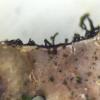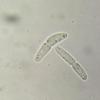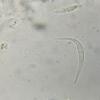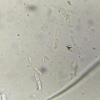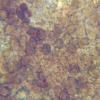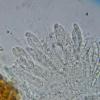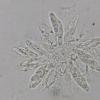
04-01-2026 17:45
 Stephen Martin Mifsud
Stephen Martin Mifsud
I was happy to find these orange asmocyetes which

03-01-2026 13:08
Niek SchrierHi all,We found groups of perithecia on a Lecanora

29-12-2025 17:44
Isabelle CharissouBonjour,J'aimerais savoir si d'autres personnes au

02-01-2026 17:43
MARICEL PATINOHi there, although I couldn't see the fruitbody, I

01-01-2026 18:35
Original loamy soil aside a artificial lake.The co

31-12-2025 19:27
Collected from loamy soil, at waterside (completel
Pronectria?
Georges Greiff,
28-01-2022 20:59
Hi all,
I found this tiny Hypocreales with mostly overmature perithecia on some degraded lichen thalli growing epiphytically, seemingly Hypotrachyna or Parmotrema (some Parmeliaceae). I wonder if it is a Pronectria. I can check other perithecia - there are dozens so I might be able to get better material with asci.
I only found old spores in the collection I looked at but they seemed rather long compared to many Pronectria species I have seen, measuring 13.5-16(-17.5) x 2-3, often asymmetrical and curved, and constricted at the septa. Some appeared to be germinating..
Thanks and all the best,
George
Alain GARDIENNET,
28-01-2022 23:08
Re : Pronectria?
It's dead, impossible to go further.
Sorry.
If you find ascomata not dead, please try to show hamathecium including asci,and try to test peridium with KOH and acid lactic.
Alain
Sorry.
If you find ascomata not dead, please try to show hamathecium including asci,and try to test peridium with KOH and acid lactic.
Alain
Franz Berger,
29-01-2022 08:54

Re : Pronectria?
HI George !
Despite the pretty poor quality of the fotos, there would be one good opininion: Trichonectria rubrofaciens, Ascospore shape and measurements are the same. Wall should be K negative.
Trichonectria ascomata tend to collaps in dry state, but are fit again when rehydrated with water.
I would wonder, if You could not find some integer ascomata. And not given in the fotos: there should be a corona of short, hyaline hairs/spikes concentreated near the ostiolum.
Only one foto disturbs my suggestion: there is a Fusarium- type conidium- which would not fit to Trichonectria, as its anamorphic state is Acremonium-type.
Franz
Despite the pretty poor quality of the fotos, there would be one good opininion: Trichonectria rubrofaciens, Ascospore shape and measurements are the same. Wall should be K negative.
Trichonectria ascomata tend to collaps in dry state, but are fit again when rehydrated with water.
I would wonder, if You could not find some integer ascomata. And not given in the fotos: there should be a corona of short, hyaline hairs/spikes concentreated near the ostiolum.
Only one foto disturbs my suggestion: there is a Fusarium- type conidium- which would not fit to Trichonectria, as its anamorphic state is Acremonium-type.
Franz
Alain GARDIENNET,
29-01-2022 09:18
Re : Pronectria?
Of course I thought at T. rubefaciens (cf 2 typical spores) . Deliberately I did not want to say it to encourage to observe a beautiful ascoma with all the criteria present. The extreme drift is to propose: a macro photo + a spore and that's it, we have already seen on this forum. Here especially, as you said in a previous message, there may be an intraspecific variety that I also observe You are right, let's encourage Georges to show us that it is Trichonectria (sensu lato).
Concerning the hairs, one of character, I recently saw an high variability (with specimens on Flavoparmelia, Parmelia or Pleurosticta. Indeed we need more observations.
The good new is that more and more mycologists are going to find lichenicolous fungi !
Have a nice day,
Alain
Georges Greiff,
29-01-2022 10:35
Re : Pronectria?
Thank you both. I will try to dissect better material this evening, perhaps make some sections as well for the structure of the peridium. It was a bit rushed when I checked this. I have K but unfortunately no lactic acid for testing.
Hopefully, I can improve the documentation.
Best wishes,
George
Kendra E. Driscoll,
29-01-2022 16:52
Re : Pronectria?
Hi George,
I replied earlier but it didn't go through. I agree with the theory that this is likely Trichonectria rubefaciens, based on the long skinny spores and superficial ascomata (I don't think the hairs/protuberances at the top are very evident in dry, collapsed perithecia). The curved pointy spore struck me as a Fusarium-like conidium rather than a germinating ascospore but I'm not sure and it could be there incidentally. You can get multiple fungi infecting one lichen thallus after all.
I mostly responded to suggest you check out the following reference in case you don't have it:
Rossman AY, Samuels GJ, Rogerson CT, Lowen R (1999) Genera of Bionectriaceae, Hypocreaceae and Nectriaceae (Hypocreales, Ascomycetes). Studies in Mycology 42. https://www.studiesinmycology.org/sim/Sim42/full%20text.htm
Good luck,
Kendra
I replied earlier but it didn't go through. I agree with the theory that this is likely Trichonectria rubefaciens, based on the long skinny spores and superficial ascomata (I don't think the hairs/protuberances at the top are very evident in dry, collapsed perithecia). The curved pointy spore struck me as a Fusarium-like conidium rather than a germinating ascospore but I'm not sure and it could be there incidentally. You can get multiple fungi infecting one lichen thallus after all.
I mostly responded to suggest you check out the following reference in case you don't have it:
Rossman AY, Samuels GJ, Rogerson CT, Lowen R (1999) Genera of Bionectriaceae, Hypocreaceae and Nectriaceae (Hypocreales, Ascomycetes). Studies in Mycology 42. https://www.studiesinmycology.org/sim/Sim42/full%20text.htm
Good luck,
Kendra
Georges Greiff,
30-01-2022 19:25
Re : Pronectria?
A couple more photos showing the elongate ascospores in asci. I'm afraid that's the best I can do with this one for now as I been prioritising other collections. Most of the perithecia seemed to be collapsed when dry. Of 6 I extracted, only this one had asci. The rest were overmature.
Some host patches also seemed to have (other) perithecia immersed in the thallus. Perhaps these are something different and where the possible anamorph came from. I'll return to the tree another time to search for better material.
Thanks for all your help everyone.
Next time, I hope to have my upgraded microscope properly set up, and hopefully time so that the examination is not rushed like this.
Best wishes,
George
Alain GARDIENNET,
09-02-2022 16:07
Re : Pronectria?
And by the way, have one of you observed it on Evernia prunastri ?



